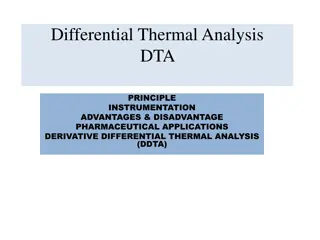Understanding Pharmaceutical Suspensions
A pharmaceutical suspension is a dispersion of finely divided insoluble material in a liquid medium, available in liquid or dry form. These suspensions are essential for unstable drugs and come in different particle sizes, from colloidal to coarse. The particles in a suspension vary in size, influencing their properties and application. Proper formulation of suspensions is crucial for various medical purposes, such as injections and ophthalmic use, ensuring patient comfort and efficacy.
- Pharmaceutical Suspensions
- Drug Formulation
- Particle Size
- Medical Preparations
- Colloidal Dispersions
Download Presentation

Please find below an Image/Link to download the presentation.
The content on the website is provided AS IS for your information and personal use only. It may not be sold, licensed, or shared on other websites without obtaining consent from the author. Download presentation by click this link. If you encounter any issues during the download, it is possible that the publisher has removed the file from their server.
E N D
Presentation Transcript
Suspension A pharmaceutical defined as a coarse dispersion containing finely divided insoluble material suspended in a liquid medium or available in dry form to be distributed in the liquid when desired. Sterile suspensions injection or for ophthalmic use. suspension may be are intended for
Drugs that are unstable if maintained for extended periods in the presence of an aqueous vehicle (e.g., many antibiotic drugs) are most frequently supplied as dry powder mixtures for reconstitution at the time of dispensing. This type of preparation is designated in the USP by a title of the form for Oral Suspension.
Most pharmaceutical suspensions consist of an aqueous dispersion medium, although in some instances it may be an organic or oily liquid. A disperse phase with a mean particle diameter of up to 1 m is usually termed a colloidal dispersion, examples a aluminium magnesium hydroxide suspensions. A solid in liquid dispersion, in which the particles are above colloidal size, is termed a coarse suspension. and includes hydroxide such and
The particles of the dispersed phase vary widely in size, from large, visible particles to colloidal dimensions, which fall between 1.0 nm and 0.5 m in size. Course dispersions contain particles 10 50 m in size and include suspensions and emulsions. Fine dispersions contain particles of smaller size, 0.5 10 m. Magmas and gels represent such fine dispersions. Particles in a coarse dispersion have a greater tendency to separate from the dispersion medium than do the particles of a fine dispersion. Most solids in a dispersion tend to settle to the bottom of the container, because their density is higher than the dispersion medium.
Suspensions contain particles of a size such that they can pass freely through the syringe needle. Needle shaped crystals are frequently desirable. Ophthalmic suspensions should be formulated such that the particles don t exceed 10 . Below this size the patient don t feel any pain. intended for injection must
For topical suspension, the particle size should be such that the patient should not feel gritty when applied to the skin. Also, the smaller the particle size the greater the covering and protective power of the preparation.
Routes of administration Suspension dosage forms are given by the oral route, injected subcutaneously, instilled intranasally, inhaled into the lungs, applied to the skin as topical preparations, or used for ophthalmic or otic purposes in the eye or ear, respectively. intramuscularly or
Advantages of suspension 1. Suspensions offer an alternative oral dosage form for patients who cannot swallow a tablet or capsule such as pediatric and geriatric patients. Oral antibiotics, antipyretic drugs are commonly administered as suspensions to these groups of patients. 2. Suspensions are often used to deliver poorly water-soluble drugs formulated as aqueous solutions. analgesic and which cannot be
3. Drugs that have an unpleasant taste may preferably be formulated as a suspension to reduce interaction of drug with taste receptors in the mouth. 4. Because suspended drug must undergo a dissolution step prior to crossing biological membranes, suspensions offer a way to provide sustained release parenteral, topical, and administration. of drug routes by of oral
5. Certain drugs are chemically unstable in solution but stable when suspended. In this instance, the suspension ensures chemical stability while permitting liquid therapy. If a drug is unstable in an aqueous medium, a different form of the drug, such as an ester or insoluble salt that does not dissolve in water may be used in the suspension. preparation of a
6. Drugs, such as antibiotics, that are unstable in the presence of an aqueous vehicle for extended periods of time are most frequently supplied as dry powder reconstitution at the time of dispensing. This type of preparation is designated in the USP by the title for Oral Suspension. 7. The dose of a liquid form may be adjusted easily to meet the patient s requirements. mixtures for
Types of suspension Based on route of administration suspensions can be classified into the following categories 1. Oral suspensions Examples of oral suspensions are the oral antibiotic syrups, which normally contain 125 to 500 mg per 5 mL of solid material. When formulated for use as pediatric drops, the concentration of suspended correspondingly greater. material is
Antacid generally contain high concentrations of dispersed solids. 2. Topical suspensions Externally applied suspensions for topical use are designed cosmetic, and protective purposes. The concentration of dispersed phase may exceed 20%. and radiopaque suspensions for dermatologic,
3. Parenteral suspensions Parenteral suspensions contain from 0.5% to 30% of solid particles. Viscosity and particle size are significant factors because they affect the ease of injection and the availability of the drug in depot therapy (injection of a drug with a substance that slows the release and prolongs the action of the drug)
Based on electro-kinetic properties 1. Deflocculated suspensions In a deflocculated particles remain as discrete units. Because the rate of sedimentation depends on the size of each unit, settling will be slow. The supernatant of a deflocculated system will continue to remain cloudy for an appreciable time after shaking, due to the very slow settling rate of the smallest particles in the product, even after the larger ones have sedimented. system the dispersed
The repulsive forces between individual particles allow them to slip past each other as they sediment. The slow rate of settling prevents the entrapment of liquid within the sediment, which thus becomes compacted and can be very difficult to redisperse.
This phenomenon is also called caking or claying, and is the most serious of all the physical stability problems suspension formulation encountered in
2. Flocculated Suspension: A flocculated suspension is a suspension in which particles have undergone flocculation. The aggregation of flocculated system will lead to a much more rapid rate of subsidence because each unit is composed of many individual therefore larger. particles in a sedimentation or particles and is
The rate of settling will also depend on the porosity of the aggregate, because if it is porous the dispersion medium can flow through, as well as around, each aggregate or floccule as it sediments. The nature of the sediment of a flocculated system is also quite different from that of a deflocculated one.
The structure of each aggregate is retained after sedimentation, thus entrapping a large amount of the liquid suspensions easily redispersed by moderate agitation. In a flocculated system the supernatant quickly becomes clear, as the large floes that settle rapidly are composed of particles of all sizes phase. Such
In summary, deflocculated systems have the advantage of a slow sedimentation rate, thereby enabling a uniform dose to be taken from the container, but when settling does occur compacted and difficult to redisperse. sediment is the
Flocculated systems form loose sediments which are easily redispersible, but the sedimentation rate is fast and there is a danger of an inaccurate dose being administered; also, the product will look inelegant.
Physical Characteristics of Suspensions Suspensions should possess several basic chemical and physical properties. The dispersed phase should settle slowly, if at all, and be re-dispersed readily upon shaking. The solid particles should have a narrow particle size distribution, which does not cake on settling, and the viscosity should preparation pours easily. be such that the
In addition, the product should have an elegant appearance, microbial growth chemical stability. be resistant maintain to its and
Physical Features of the Dispersed Phase of a Suspension The reduction in the particle size is beneficial to the suspension in that sedimentation is particles are decreased in size. The reduction in particle size produces slow, more uniform rates of settling. stability the reduced of the of the rate as
However, reduction of the particle size to too fineness should be avoided, since fine particles have a tendency to form a compact cake upon settling. The result may be that the cake resists breakup upon shaking, aggregates of particles. and forms rigid
Dispersion Medium Highly flocculated particles usually settle too rapidly, that might hinders measurement of accurate dosage and, from an aesthetic point of view, produces too unsightly a supernatant layer. In many commercial suspending agents are added to the dispersion medium to lend it structure. suspensions,
Suspending agents Viscosity-increasing sedimentation rate of particles in a vehicle in which they are not soluble. Agar Bentonite Carbomer (e.g., Carbopol) (Poly(acrylic acid) Carboxymethylcellulose sodium Hydroxyethyl cellulose Hydroxypropyl cellulose Hydroxypropyl methylcellulose Kaolin agent used to reduce
Methylcellulose Tragacanth Veegum
When polymeric substances and hydrophilic colloids are used as suspending agents, it must be assured that the agent does not interfere with availability of the drug. These materials can bind certain medicinal agents, rendering them unavailable or only slowly available for therapeutic function. Also, the amount of the suspending agent must not be such to render the suspension too viscous to agitate or to pour.
Settling in suspensions One aspect pharmaceutical suspensions is concerned with keeping the particles uniformly distributed throughout the dispersion. Although it is seldom possible to prevent settling completely over a prolonged period of time, it is necessary to consider the factors that influence the velocity of sedimentation. of physical stability in
Several factors influence the sedimentation rate of particles in a suspension. Stokes law relates the diameter of the particles, the density of the particles and the medium, and the medium to the sedimentation rate: =2 r2( - o)g /9 viscosity of the
Where is the sedimentation rate r is the radius of the particles is the density of the particles ois the density of the medium g is the gravitational constant and is the viscosity of the medium.
From the equation, it is apparent that the velocity of fall of a suspended particle is greater for larger particles than it is for smaller particles. Reducing the particle size of the dispersed phase produces a slower rate of sedimentation. Also, the greater the density of the particles, the greater sedimentation, provided the density of the vehicle is not altered the rate of
Because aqueous vehicles are used in pharmaceutical oral density of the particles is generally greater than that of the vehicle. If the particles were less dense than the vehicle, they would tend to float, and floating particles would be quite difficult to distribute uniformly in the vehicle. suspensions, the
The appreciably reduced by increasing the viscosity of the However, a product with too high viscosity is not generally desirable because it pours with difficulty and it is equally difficult to redisperse the suspensoid. rate of sedimentation may be dispersion medium.
Therefore, if the viscosity of a suspension is increased, it is done so only to a modest extent to avoid these difficulties. The viscosity characteristics of a suspension may be altered not only by the vehicle used but also by the solid content. As the proportion of solid particles in a suspension increases, so does the viscosity.
The formulation of suspensions is the size of the drug particles. In most pharmaceutical suspensions, the particle between 1 and 50 m. most important consideration in diameter is
Effect of Brownian movement For particles having a diameter of about 2 to 5 m (depending on the density of the particles and the density and viscosity of the suspending medium), movement counteracts sedimentation to a measurable extent at room temperature by keeping the dispersed material in random motion. Brownian
smallest Brownian particles of a pharmaceutical suspension is usually eliminated when the sample is dispersed in a 50% glycerin solution, having a viscosity of about 5 centipoise. Hence, it is unlikely that the particles in an ordinary pharmaceutical containing suspending agents are in a state of vigorous Brownian motion. movement of the suspension
Sedimentation of Flocculated Particles When sedimentation flocculated systems, it is observed that the flocs tend to fall together, producing a distinct boundary between the sediment and the supernatant liquid. The liquid above the sediment is clear because even the small particles present in the system are associated with the flocs. is studied in
Such is not the case in deflocculated suspensions having a range of particle sizes, in which, in accordance with Stokes's law, the larger particles settle more rapidly than the smaller particles.
No clear boundary is formed (unless only one size of particle is present), and the supernatant remains turbid for a considerably longer period of time. Whether the supernatant liquid is clear or turbid during the initial stages of settling is a good indication of whether the system is flocculated or deflocculated, respectively.
Sedimentation Parameters Two useful parameters that can be derived from sedimentation studies are sedimentation volume, V, or height, H, and degree of flocculation. Sedimentation volume The sedimentation volume, F, is defined as the ratio of the final, or ultimate, volume of the sediment, Vu, to the original volume of the suspension, Vo, before settling .
F=Vu/V0 The sedimentation volume can have values ranging from less than 1 to greater than 1. F is normally less than 1, and in this case, the ultimate volume of sediment is smaller than the original volume of suspension, in which F = 0.5.
If the volume of sediment in a flocculated suspension original volume of suspension, then F = 1. Such a product is said to be in flocculation equilibrium and shows no clear supernatant on standing. It is therefore pharmaceutically acceptable. equals the
It is possible for F to have values greater than 1, meaning that the final volume of sediment is greater than the original suspension volume. This comes about because the network of flocs formed in the suspension is so loose and fluffy that the volume they are able to encompass is greater than the original volume of suspension. In example shown, F = 1.5.
Degree of flocculation Amore useful parameter for flocculation is , the degree of flocculation. If we consider a suspension that is completely deflocculated, the ultimate sediment will be relatively small. Writing this volume as V , based on equation, we have volume of the F =V /V0
Where F is the sedimentation volume of the deflocculated, or peptized, suspension. The degree of flocculation, , is therefore defined as the ratio of F to F , or =F/F Substituting the value of F and F =Vu/V0 V /V0 = Vu/V























